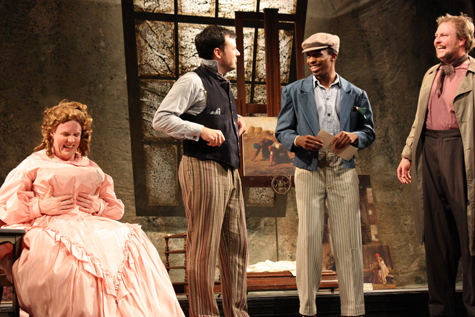
PLAYING DEAD Dustin Tucker, left, has two roles in Twain’s farce.
|
Though a famous man in his own lifetime, the quintessentially American humorist Mark Twain was never known as a playwright in his day. But such is the writer's prestige and proximity to our hearts that when a scholar found and dusted off a script called Is He Dead? in 2003, it was only a few short years before David Ives was adapting it on Broadway. If you, too, are curious about Twain the playwright, you're in luck: It is produced in repertory this summer at the Theater at Monmouth, under the capable direction of Will Rhys.
Twain's 1898 play takes as protagonist the real-life French painter Jean-François Millet, but with oodles of fictionalized liberties. Millet (Dustin Tucker) and his ragtag bohemian coterie of fellow painters — including Agamemnon "Chicago" Buckner (Mike Anthony), Hans "Dutchy" Von Bismarck (Dennis A. Price), and Phelim O'Shaughnessy (J.J. Smith III) — are all broke. Nor are they selling any paintings, not even Millet, whose naturalist pastoral scenes they all idolize. This is a particular problem because Papa Leroux (Gene D'Alessandro), father of the women beloved by Millet and Agamemnon, Marie and Cecile (Grace Trull and Clare Brower), owes money to arch-villain Bastien Andre (Mark S. Cartier). Andre vows to essentially ruin everyone unless Marie agrees to marry him. So francs simply must be made from Millet's art. But when a wealthy American collector loses interest upon discovering Millet to be still living and breathing, the artist anguishes that he seems to be worth more dead than alive.
You will have already guessed where this is going. Agamemnon lays out the particulars of the scheme he will sell to the public: Millet will acquire some fascinating disease, decline for a while to drive up his prices, and then "die." But he'll be able to enjoy his legacy in "thick disguise," as his own widowed twin sister, "Daisy."
And so there in Millet's studio, under a slanted atelier window mottled with sienna and black as if from a mix of dissolution and flung paint, and amid a multitude of unsold and as yet unsellable Millet canvases (reproductions of the real-life Millet's paintings; kudos to scenic and props designers Dan Bilodeau and Rachel Slotnick), the four painters set out to scam the international art world. What follows is a richly cynical commentary on art as a commodity, the nature of fame and "value," and the manipulability of popular opinion.
While the premise of Is He Dead? is deliciously sophisticated, the humor of its action is often gleefully low: It includes innocuous fun had at the expense of Continental manners (including Wurst jokes, mockery of the French cheek-kissing, and a recurring bit with Limburger cheese), as well as your typical farce fare (cross-dressing gags), jabs at gender conventions (regarding corsets and "female hysteria"), and a few barbs aimed Stateside (Daisy and her brother are "closer than a Congressman and a pork barrel").
The cast is game and swift, and as Millet and "Daisy," Tucker twitches, pouts, rages, and flirts with a falsetto in a spectacle of physical comedy that his fans will recognize as vintage Tucker. Among all the amusing situational misunderstandings that Millet breeds, a particular treat is how jealous Cecile mistakes Agamemnon and "Daisy's" tetchy and ironic baiting of each other as romantic intimacy.